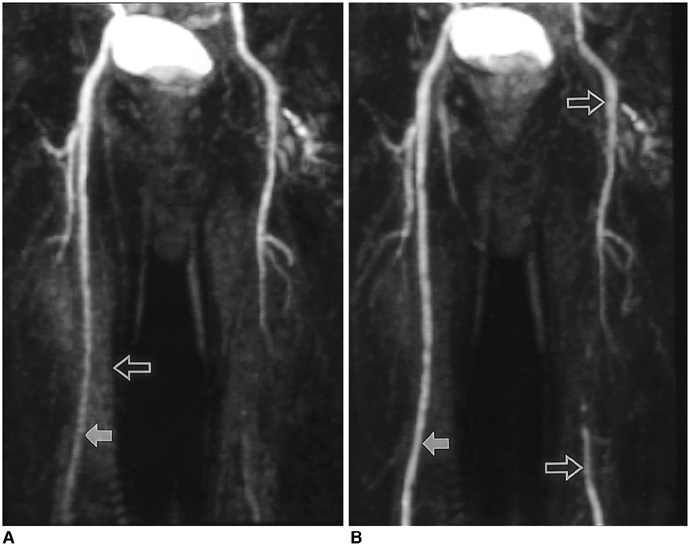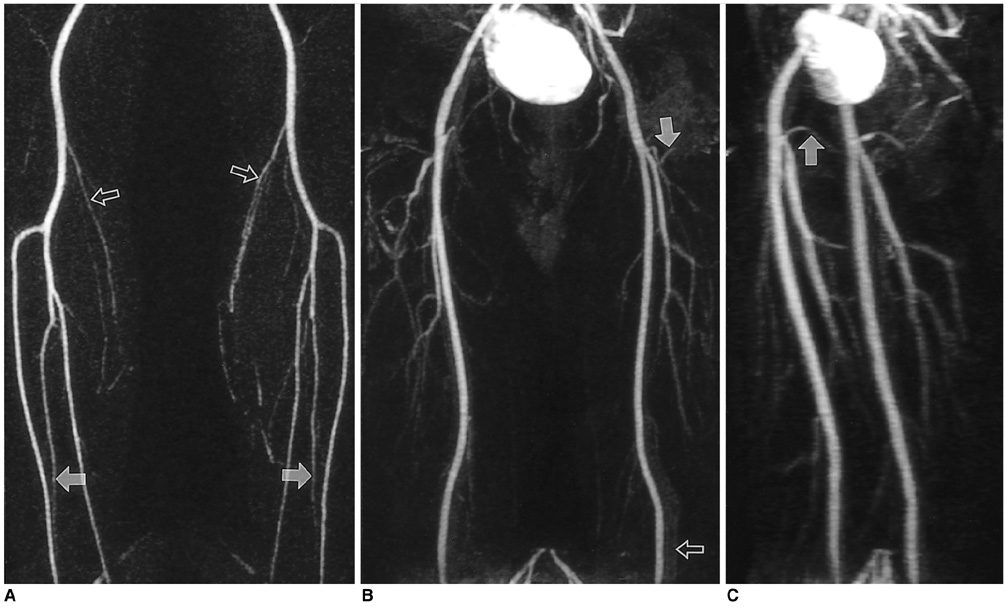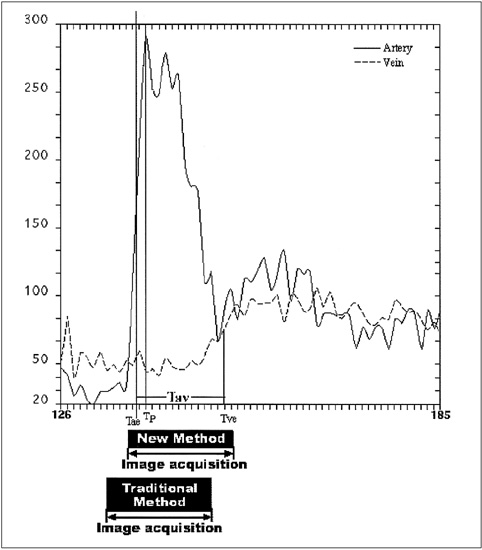Korean J Radiol.
2000 Sep;1(3):142-151. 10.3348/kjr.2000.1.3.142.
The Optimization of Scan Timing for Contrast-Enhanced Magnetic Resonance Angiography
- Affiliations
-
- 1Department of Diagnostic Radiology, School of Medicine, Kyungpook National University, Taegu, South Korea. jonglee@knu.ac.kr
- KMID: 877074
- DOI: http://doi.org/10.3348/kjr.2000.1.3.142
Abstract
OBJECTIVE
To determine the optimal scan timing for contrast-enhanced magnetic resonance angiography and to evaluate a new timing method based on the arteriovenous circulation time. MATERIALS AND METHODS: Eighty-nine contrast-enhanced magnetic resonance angiographic examinations were performed mainly in the extremities. A 1.5T scanner with a 3-D turbo-FLASH sequence was used, and during each study, two consecutive arterial phases and one venous phase were acquired. Scan delay time was calculated from the time-intensity curve by the traditional (n = 48) and/or the new (n = 41) method. This latter was based on arteriovenous circulation time rather than peak arterial enhancement time, as used in the traditional method. The numbers of first-phase images showing a properly enhanced arterial phase were compared between the two methods. RESULTS: Mean scan delay time was 5.4 sec longer with the new method than with the traditional. Properly enhanced first-phase images were found in 65% of cases (31/48) using the traditional timing method, and 95% (39/41) using the new method. When cases in which there was mismatch between the target vessel and the time-intensity curve acquisition site are excluded, erroneous acquisition occurred in seven cases with the traditional method, but in none with the new method. CONCLUSION: The calculation of scan delay time on the basis of arteriovenous circulation time provides better timing for arterial phase acquisition than the traditional method.
Keyword
MeSH Terms
Figure
Reference
-
1. Earls JP, Rofsky NM, DeCorato DR, Krinsky GA, Winreb JC. Breath-hold single-dose gadolinium-enhanced three-dimensional MR aortography: usefulness of a timing examination and MR power injector. Radiology. 1996. 201:705–710.2. Prince MR. Gadolinium-enhanced MR aortography. Radiology. 1994. 191:155–164.3. Debatin JF, Spritzer CE, Grist TM, et al. Imaging of the renal arteries: value of MR angiography. AJR. 1991. 157:981–990.4. Prince MR, Narasimham DL, Stanley JC, et al. Breath-hold gadolinium-enhanced MR angiography of the abdominal aorta and its major branches. Radiology. 1995. 197:785–792.5. Holland GA, Dougherty L, Carpenter JP, et al. Breath-hold ultrafast three-dimensional gadolinium-enhanced MR angiography of the aorta and the renal and other visceral abdominal arteries. AJR. 1996. 166:971–981.6. Snidow JJ, Johnson MS, Harris VJ, et al. Three-dimensional gadolinium-enhanced MR angiography for aortoiliac inflow assessment plus renal artery screening in a single breath-hold. Radiology. 1996. 198:725–732.7. Leung DA, McKinnon GC, Davis CP, Pfammatter T, Krestin GP, Debatin JF. Breath-hold, contrast-enhanced, three dimensional MR angiography. Radiology. 1996. 201:569–571.8. Lin W, Haacke EM, Smith AS, Clampitt ME. Gadolinium-enhanced high-resolution MR angiography with adaptive vessel tracking: preliminary results in the intracranial circulation. J Magn Reson Imaging. 1992. 2:277–284.9. Marchal G, Bosmans H, Van Fraeyenhoven L, et al. Intracranial vascular lesions: optimization and clinical evaluation of three-dimensional time-of-flight MR angiography. Radiology. 1990. 175:443–448.10. Prince MR, Yucel EK, Kaufman JA, et al. Dynamic gadolinium-enhanced three-dimensional abdominal MR arteriography. J Magn Reson Imaging. 1993. 3:877–881.11. Pavone P, Giuliani S, Cardone G, et al. Intraarterial portography with gadopentetate dimeglumine: improved liver-to-lesion contrast in MR imaging. Radiology. 1991. 179:693–697.12. Losef SV, Rajan SS, Patt RH, et al. Gadolinium-enhanced magnitude contrast MR angiography of popliteal and tibial arteries. Radiology. 1992. 184:349–355.13. Adamis MK, Li W, Wielopolski PA, et al. Dynamic contrast-enhanced subtraction MR angiography of the lower extremities: initial evaluation with a multisection two-dimensional time-of-flight sequence. Radiology. 1995. 196:689–695.14. Kopka L, Vosshenrich R, Mueller D, Fischer U, Rodenwaldt J, Grabbe E. Results of a contrast-enhanced three-dimensional MR angiography in a single breath-hold after optimization of the contrast material bolus. Fortschr Rontgenstr. 1997. 166:15–20.15. Ho KY, Leiner T, de Haan MW, Kessels AG, Kitslaar PJ, Engelshoven JM. Peripheral vascular tree stenoses: evaluation with moving-bed infusion-tracking MR angiography. Radiology. 1998. 206:683–692.16. Foo TK, Saranathan M, Prince MR, Chenevert TL. Automated detection of bolus arrival and initiation of data acquisition in fast, three-dimensional, gadolinium-enhanced MR angiography. Radiology. 1997. 203:275–280.17. Kopka L, Vosshenrich R, Rodenwaldt J, Grabbe E. Differences in injection rates on contrast-enhanced breath-hold three-dimensional MR angiography. AJR. 1998. 170:345–348.18. Willems JL, Roelandt JR, Van de Vel HR, Joossens JV. The circulation time in the elderly. Am J Cardiol. 1971. 27:155–161.19. Pierson RN, Grieco M, Swinton N, Dubin M. Circulation time end points: a quantitative comparison of saccharin and radioiodinated albumin as indicators. Circulation. 1966. 34:997–1004.20. Selzer A, Dunlap RW, Wray HW, Russell J. A critical appraisal of the circulation time test. Arch Intern Med. 1968. 122:491–495.21. Becker GJ, Holden RW. Sodium dehydrocholate circulation times in digital subtraction angiography. AJR. 1983. 140:817–818.22. Lauzon ML, Holdsworth DW, Frayne R, Rutt BK. Effects of physiologic waveform variability in triggered MR imaging: theoretical analysis. J Magn Reson Imaging. 1994. 4:853–867.23. Mezrich R. Perspective on k space (tutorial). Radiology. 1995. 195:297–315.24. Maki JH, Prince MR, Londy FJ, Chenevert TL. The effects of time varying intravascular signal intensity and k-space acquisition order on three-dimensional MR angiography image quality. J Magn Reson Imaging. 1996. 6:642–651.
- Full Text Links
- Actions
-
Cited
- CITED
-
- Close
- Share
- Similar articles
-
- Optimal Cardiac Magnetic Resonance Contrast-Enhanced Timing Robust Angiography (CMR-CENTRA) for the Three-Dimensional Reconstruction of the Bilateral Atria in the Electroanatomic Mapping (EAM) of Atrial Fibrillation
- Contrast-Enhanced Magnetic Resonance Angiography: Dose the Test Dose Bolus Represent the Main Dose Bolus Accurately?
- Principles of Magnetic Resonance Angiography Techniques
- Assessment of Contrast-enhanced 3D Ultrafast Pulmonary MR Angiography Using Test Injection: Comparison betweenSingle Dose and Double Dose
- Image Findings in Brain Developmental Venous Anomalies







